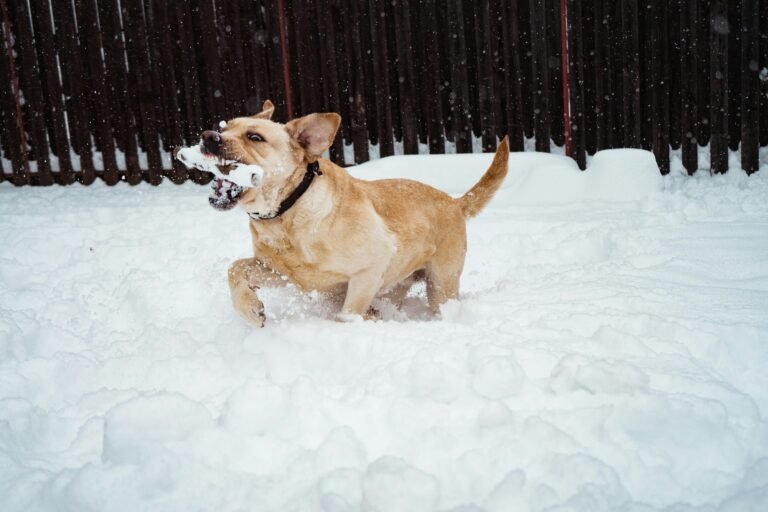Introduction
For many dog owners, winter means cozy nights indoors, snowy walks, and festive fun. But while we enjoy the season, our furry friends often face hidden dangers underfoot. Snow, ice, road salt, and freezing temperatures can cause painful injuries to a dog’s paws if not properly protected. Cracked pads, chemical burns, and frostbite are all risks when dogs spend time outdoors during cold months. The good news? With the right care and preparation, you can keep your pup’s paws safe, comfortable, and healthy throughout the winter season.
Why Winter Is Tough on Dog Paws
Dogs’ paw pads are tough, but they aren’t invincible. During winter, several hazards come into play:
- Snow and Ice: Ice can create small cuts or abrasions, while snow buildup between toes can cause discomfort and lead to frostbite if left untreated.
- Road Salt and Deicers: These chemicals melt ice but are harsh on paws, leading to irritation, dryness, or even chemical burns. They can also be toxic if licked off.
- Cold Temperatures: Just like humans, dogs can suffer frostbite or hypothermia if exposed too long to extreme cold without protection.
Pre-Walk Preparation
Taking a few steps before heading outside can make a big difference for your dog’s comfort and safety:
- Trim Fur Between Paw Pads: Long hair traps snow and ice, which can form painful ice balls. Keep fur neatly trimmed to reduce buildup.
- Apply Paw Balm or Wax: Products like Musher’s Secret create a protective barrier against salt and cold, reducing dryness and cracking.
- Check the Weather: Plan walks during warmer parts of the day when sidewalks are less icy, and avoid extended outdoor time in extreme cold.
The Case for Dog Boots
Dog boots may look cute, but they serve a serious purpose in winter care. They provide insulation, traction, and a physical barrier against chemicals and ice. Modern boots come in various styles — from lightweight slip-ons to rugged, all-terrain designs. If your dog resists wearing them, introduce boots gradually indoors with positive reinforcement. Start with short sessions and reward them with treats until your pup becomes comfortable.
For dogs that refuse boots, using a paw balm or wax before walks and thoroughly cleaning paws afterward can still provide strong protection.
During the Walk: Staying Vigilant
Once outside, pay attention to your dog’s behavior and surroundings:
- Avoid Heavily Salted Areas: Stick to grassy patches, parks, or areas treated with pet-safe deicers if possible.
- Watch for Limping or Licking: If your dog stops to lick their paws excessively, it may signal irritation from salt or ice.
- Shorter Walks: Multiple short walks are safer than one long outing during freezing conditions, reducing exposure to cold and chemicals.
Post-Walk Paw Care
Caring for paws after winter walks is just as important as preparing beforehand:
- Rinse and Dry: Use warm water to rinse away salt, ice, and chemicals. Dry paws thoroughly to prevent moisture-related issues like fungal infections.
- Moisturize Pads: Apply dog-safe moisturizers (avoid human lotions, which may contain toxic ingredients). This prevents cracking and keeps paw pads supple.
- Inspect for Damage: Look for cuts, redness, swelling, or foreign objects between toes. Treat minor scrapes promptly and consult a vet if you notice persistent issues.
Signs of Winter Paw Problems
Even with precautions, winter conditions can take a toll. Watch for these warning signs:
- Excessive licking or chewing of paws
- Red, inflamed, or swollen pads
- Bleeding cracks in paw pads
- Limping or reluctance to walk
- Discoloration or unusual odors
Address issues early to prevent minor irritations from turning into painful infections.
DIY Paw Protection Solutions
If commercial paw balms aren’t available, you can make simple at-home remedies. A mixture of coconut oil, shea butter, and beeswax creates a natural, protective coating for paw pads. Apply a thin layer before walks and reapply as needed. Always ensure paws are clean before application to avoid trapping irritants.
Indoor Winter Care Tips
Protecting your dog’s paws doesn’t stop when you come inside. Cold weather can dry indoor air, causing cracked pads and skin irritation. Here’s how to help indoors:
- Use a humidifier to prevent dryness in your home.
- Keep paws clean and moisturized daily.
- Provide cozy, warm bedding off cold floors to help regulate body temperature.
Special Considerations for Different Breeds
Some breeds tolerate cold weather better than others, but all dogs need paw protection:
- Cold-Hardy Breeds (e.g., Huskies, Malamutes): Their thick coats protect against the cold, but their paws are still vulnerable to salt and ice.
- Small or Short-Haired Breeds (e.g., Chihuahuas, Greyhounds): These dogs are more sensitive to cold overall and benefit greatly from boots and balms.
- Senior Dogs: Older dogs often have thinner paw pads and may need extra protection and shorter outdoor sessions.
Pet-Safe Alternatives to Salt
If you manage your own driveway or sidewalks, consider using pet-safe deicing products. Options like magnesium chloride or calcium magnesium acetate are less harsh than traditional rock salt. Sand or gravel can also provide traction without harming paws.
Conclusion
Winter may bring snow and ice, but it doesn’t have to mean discomfort for your dog. By preparing before walks, protecting paws during outdoor time, and following up with proper post-walk care, you can prevent injuries and keep your furry companion safe. Whether you use boots, balms, or simple rinsing routines, consistency is key. With a little extra attention, your dog will enjoy the winter season as much as you do — safely, happily, and paw-sitively protected.






